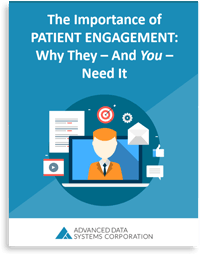Healthcare Blog
The latest in all things RCM, Electronic Health Records, Radiology Information Systems, Practice Management, Medical Billing, Value-Based Care, & Healthcare IT.

Electronic Health Records | Industry News | Radiology Information System | Patient Portal
By:
Advanced Data Systems Corporation
March 13th, 2019
If you're a physician, nurse, or another type of healthcare provider, you know what a huge burden prior authorization can be as it's extremely time-consuming. In fact, almost 90 percent of doctors have reported that prior authorization has become worse over the last five years. Here's what you need to know about prior authorization, along with the importance of choosing the best electronic prior authorization software.

Medical Billing / RCM | Industry News | Genetics | Genomic Testing
By:
Advanced Data Systems Corporation
March 6th, 2019
Moving into the Future as Predicted in Science Fiction Innovative solutions continue to develop through advanced technology. It is looking more and more like we are on course to arrive in the future when Dr. McCoy quickly waves his infamous diagnostic tool over an endeared crew member to make a quick diagnosis and treat his comrade. If you haven't heard about it, this technology has been conquered. There is one thing we know for sure, technology is propelling us into the future.

The Importance of Patient Engagement: Why They - And You - Need It
Learn why patient engagement is a necessity and how you can master it within your practice.

By:
Marc Klar
March 4th, 2019
When ADS began in 1977 “mips” was a typo for “maps.” A “good patient experience” meant he or she survived. “Mobility” meant you were able to make an appointment from a pay phone.

Medical Billing / RCM | Electronic Health Records | Healthcare Advice
By:
Advanced Data Systems Corporation
February 27th, 2019
If you're a medical professional, you probably know by now that since the beginning of 2019, PQRS, which is an acronym for Physician Quality Reporting System, has been replaced with MIPS. Maybe you've heard about these changes but aren't sure how they can improve your practice. Here's what you need to know about MIPS and its benefits, along with the importance of having the software for tracking composite scores.

Electronic Health Records | Industry News | Radiology Information System | Patient Portal
By:
Advanced Data Systems Corporation
February 20th, 2019
It takes a lot of time and dedication to run a successful radiology practice. Many practices rely on obsolete systems based on paper to maintain files on patients and organize their work. These practices are at a severe disadvantage compared to practices which use a radiology information system.

Medical Billing / RCM | Electronic Health Records | Healthcare Advice
By:
Advanced Data Systems Corporation
February 13th, 2019
Revenue Cycle Management (RCM) is an expensive, complex, but nonetheless critical element of every healthcare operation. Mismanaged RCM operations can result in higher staff turnover, reduced patient satisfaction, crippled healthcare processes, inaccurate medical billing, mounting debt, damaged reputations, and poor revenue. RCM is difficult to effectively implement. Fortunately, there are modern, 21st-century solutions to the RCM dilemma that enable the healthcare provider to harness the power of technology to disentangle their RCM processes and boost their revenue.

Medical Billing / RCM | Electronic Health Records | Industry News | Patient Portal
By:
Advanced Data Systems Corporation
February 8th, 2019
Medics FlowText: The Technology to Scale Your Clinic Process Voice-navigated charting has come a long way. We want clinicians to see how more efficient charting can be with our Medics FlowText application. First, let's look at what is powering our voice-recognition dictation.

By:
Advanced Data Systems Corporation
February 1st, 2019
IT streamlines back-office and other administrative tasks for physicians David Barzillai, founder and president, Advanced Data Systems Corp.

By:
Stephen O'Connor
January 29th, 2019
Do you own or manage a large radiology business and are noticing a decline in your patient population? Or maybe your problem is not being able to maintain a competent workforce. If these issues describe you, your dilemma could be linked to using outdated ways of keeping records. More and more healthcare professionals are becoming aware of the need to modernize how records are kept by using a state-of-the-art radiology information system (RIS). Here are some of the pros and cons of a radiology information system and its software, along with a few considerations and warnings. What Is a Radiology Information System? Even though radiology information systems were first introduced in the 1980s, many people are still unfamiliar with them. Basically, a radiology information system is a software system used to manage medical data and imagery. It's used to track radiology, imaging orders, and billing information. The system allows you to combine several functions into a single comprehensive system.

Medical Billing / RCM | Electronic Health Records | Industry News | Healthcare Advice
By:
Advanced Data Systems Corporation
January 3rd, 2019
We’re presenting here some easy-to-understand basics on MACRA for 2019. Many more exciting details can be found on www.cms.gov which should definitely be consulted if those details are needed.